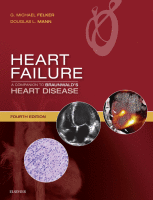Physical Address
304 North Cardinal St.
Dorchester Center, MA 02124

Definition The term dilated cardiomyopathy (DCM) refers to a spectrum of heterogeneous myocardial disorders ( Table 20.1 ) that are characterized by ventricular dilation and depressed myocardial contractility in the absence of abnormal loading conditions (such as hypertension or valvular…

Despite significant progress in the prevention and treatment of cardiovascular disease over the past 30 years, national statistics indicate that the incidence and prevalence of heart failure (HF) continue to rise. This has occurred during a time period in which…

Improved outcomes of acute cardiac conditions, population aging, increasing prevalence of lifestyle risk factors, and advances in heart failure (HF) therapeutics all have led to an increasing prevalence of HF. Because of these trends, HF has become a public health…

Overview of Cardiac Metabolism Hallmarks and Regulation of Cardiac Energy Metabolism Cardiac energy metabolism is essential to maintain cardiac pump function. To enable the heart to beat 100,000 times a day for a lifetime, the heart exhibits a highly regulated…

The syndrome of heart failure (HF) is characterized by adaptations in numerous physiologic systems that contribute to disease symptomology and progression. The cardinal symptom of HF, exercise intolerance, which manifests as dyspnea and skeletal muscle fatigue, has long been attributed…

Control of circulating blood volume is a tightly regulated physiological process and is critical for maintaining cardiovascular homeostasis. Under normal homeostatic conditions, there is extensive cross-talk between the kidney and the heart (the “cardiorenal axis”) that is essential for regulation…

The complex pathology of heart failure (HF) can be attributed, at least in part, to important changes that occur in the peripheral circulation. As cardiac output declines, systemic perfusion pressure is maintained predominantly by peripheral vasoconstriction and sodium retention, both…

Despite substantive advances in medical and device therapy of heart failure, symptom burden and rates of hospitalization and death remain high. Increased plasma norepinephrine (NE) concentration, its rate of appearance in coronary sinus efflux, and diminished tonic and reflex heart…

One of the major conceptual advances in the field of heart failure (HF) has been the recognition that HF progresses because of the structural changes that occur in the heart in response to hemodynamic, neurohormonal, epigenetic and genetic factors. Although…

Acknowledgment Supported by grants from CVON (Cardioavasculair Onderzoek Nederland), Dutch Heart Foundation, The Hague (RECONNECT, EARLY HFPEF). Heart failure (HF) with preserved ejection fraction (EF; HFpEF) currently accounts for greater than 50% of all HF cases, and its prevalence relative…